reset MERCEDES-BENZ CL-Class 2011 C216 Owner's Manual
[x] Cancel search | Manufacturer: MERCEDES-BENZ, Model Year: 2011, Model line: CL-Class, Model: MERCEDES-BENZ CL-Class 2011 C216Pages: 480, PDF Size: 19.76 MB
Page 9 of 480
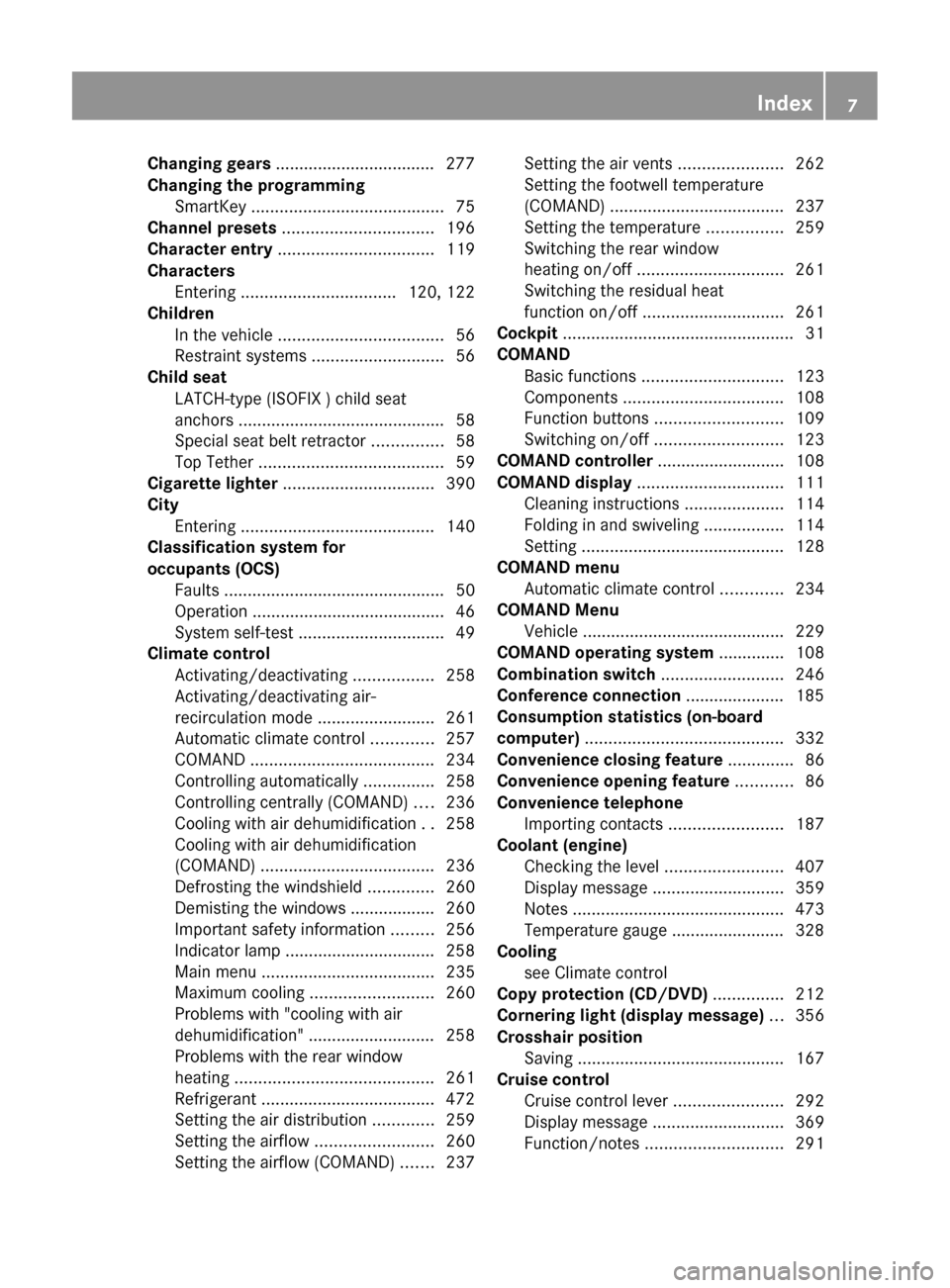
Changing gears .................................. 277
Changing the programming SmartKey ......................................... 75
Channel presets ................................ 196
Character entry ................................. 119
Characters Entering ................................. 120, 122
Children
In the vehicle ................................... 56
Restraint systems ............................ 56
Child seat
LATCH-type (ISOFIX ) child seat
anchors ............................................ 58
Special seat belt retractor ...............58
Top Tether ....................................... 59
Cigarette lighter ................................ 390
City Entering ......................................... 140
Classification system for
occupants (OCS) Faults ............................................... 50
Operation ......................................... 46
System self-test ............................... 49
Climate control
Activating/deactivating .................258
Activating/deactivating air-
recirculation mode .........................261
Automatic climate control .............257
COMAND ....................................... 234
Controlling automatically ...............258
Controlling centrally (COMAND) ....236
Cooling with air dehumidification ..258
Cooling with air dehumidification
(COMAND) ..................................... 236
Defrosting the windshield ..............260
Demisting the windows .................. 260
Important safety information .........256
Indicator lamp ................................ 258
Main menu ..................................... 235
Maximum cooling .......................... 260
Problems with "cooling with air
dehumidification" ........................... 258
Problems with the rear window
heating .......................................... 261
Refrigerant ..................................... 472
Setting the air distribution .............259
Setting the airflow .........................260
Setting the airflow (COMAND) .......237Setting the air vents ......................262
Setting the footwell temperature
(COMAND) ..................................... 237
Setting the temperature ................259
Switching the rear window
heating on/off ............................... 261
Switching the residual heat
function on/off .............................. 261
Cockpit ................................................. 31
COMAND Basic functions .............................. 123
Components .................................. 108
Function buttons ........................... 109
Switching on/off ........................... 123
COMAND controller ........................... 108
COMAND display ............................... 111
Cleaning instructions .....................114
Folding in and swiveling .................114
Setting ........................................... 128
COMAND menu
Automatic climate control .............234
COMAND Menu
Vehicle ........................................... 229
COMAND operating system .............. 108
Combination switch .......................... 246
Conference connection ..................... 185
Consumption statistics (on-board
computer) .......................................... 332
Convenience closing feature .............. 86
Convenience opening feature ............ 86
Convenience telephone Importing contacts ........................187
Coolant (engine)
Checking the level .........................407
Display message ............................ 359
Notes ............................................. 473
Temperature gauge ........................ 328
Cooling
see Climate control
Copy protection (CD/DVD) ............... 212
Cornering light (display message) ... 356
Crosshair position Saving ............................................ 167
Cruise control
Cruise control lever .......................292
Display message ............................ 369
Function/notes ............................. 291Index7
Page 18 of 480

Rear compartmentSetting the air vents ......................263
Rear fog lamp (display message) ..... 357
Rear view camera .............................. 314
Rear view camera (cleaning
instructions) ...................................... 414
Rear-view mirror Dipping (automatic) .......................101
Rear window blind ............................ 389
see Rear window roller sunblind
Rear window heating
Malfunction .................................... 261
Switching on/off ........................... 261
Redials ................................................ 184
Refueling ............................................ 281
Remote control .................................. 115
Programming (garage door
opener) .......................................... 398
Reporting
Malfunctions relevant to safety ........ 26
Reserve (fuel tank)
see Fuel
Reserve fuel
Display message ............................ 362
Warning lamp ................................. 380
Reset .................................................. 135
Residual heat Switching on/off ........................... 261
Restraint systems
see SRS
Reversing lamp (display message) .. 358
Roadside Assistance (breakdown) .... 24
Roller sunblind Rear window .................................. 389
Rear window (COMAND) ................230
Roof lining and carpets (cleaning
guidelines) ......................................... 417
Route Calculating ..................................... 141
Estimated time of arrival ................156
Route overview .............................. 157
see Route guidance (on-board
computer)
Route calculation
Starting .......................................... 141
Route guidance .................................. 151
Cancel ........................................... 154Continue ........................................ 154
Continuing ..................................... 154
Destination reached ......................155
Lane recommendations .................153
Off-road ......................................... 158
Traffic reports ................................ 159
Route guidance (on-board
computer) .......................................... 333
Route options Setting ........................................... 137
Route overview .................................. 157
Route type Setting ........................................... 137
S
Safety Children in the vehicle .....................56
Child restraint systems ....................56
Occupant Classification System
(OCS) ............................................... 46
Overview of occupant safety
systems ........................................... 40
Safety notes
Audio CD/DVD and MP3 mode .....204
Operating safety ....................106, 237
Using the telephone ....................... 178
Video DVD mode ........................... 223
Safety systems
see Driving safety systems
SatRadio ............................................. 200
Displaying information ...................204
Registering .................................... 201
Selecting a category ......................202
Switching to ................................... 201
SD memory card
Loading .......................................... 205
Seat
Active multicontour seat .......... 97, 240
Selecting (COMAND) .....................238
Seat belts
Automatic comfort-fit feature ..........55
Belt force limiters ............................ 55
Cleaning ......................................... 416
Correct usage .................................. 52
Emergency Tensioning Devices ........ 55
Fastening ......................................... 53
Important safety guidelines .............51
16Index
Page 19 of 480
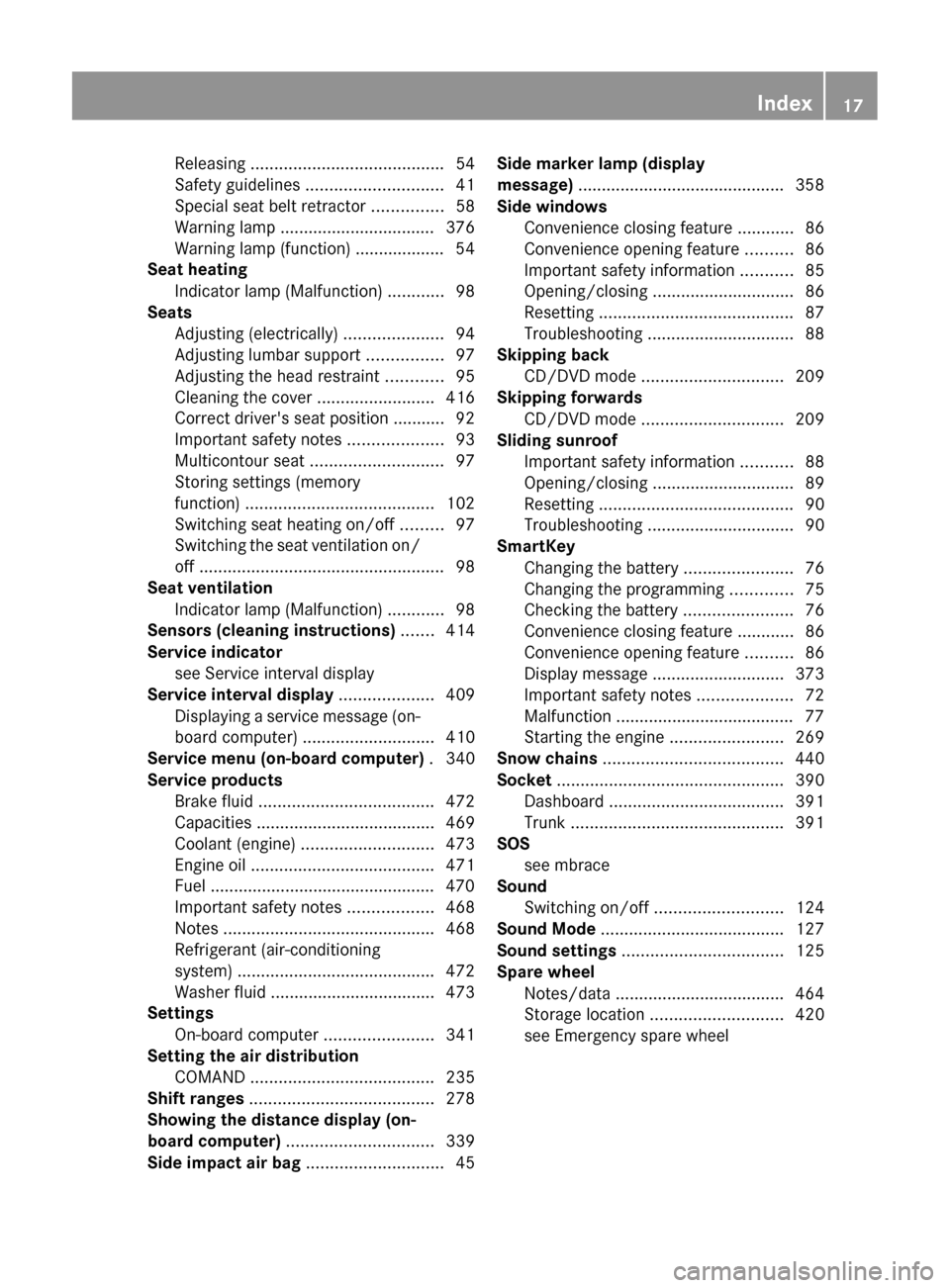
Releasing ......................................... 54
Safety guidelines ............................. 41
Special seat belt retractor ...............58
Warning lamp ................................. 376
Warning lamp (function) ................... 54
Seat heating
Indicator lamp (Malfunction) ............98
Seats
Adjusting (electrically) .....................94
Adjusting lumbar support ................97
Adjusting the head restraint ............95
Cleaning the cover .........................416
Correct driver's seat position ........... 92
Important safety notes ....................93
Multicontour seat ............................ 97
Storing settings (memory
function) ........................................ 102
Switching seat heating on/off .........97
Switching the seat ventilation on/
off .................................................... 98
Seat ventilation
Indicator lamp (Malfunction) ............98
Sensors (cleaning instructions) ....... 414
Service indicator see Service interval display
Service interval display .................... 409
Displaying a service message (on-
board computer) ............................ 410
Service menu (on-board computer) . 340
Service products Brake fluid ..................................... 472
Capacities ...................................... 469
Coolant (engine) ............................ 473
Engine oil ....................................... 471
Fuel ................................................ 470
Important safety notes ..................468
Notes ............................................. 468
Refrigerant (air-conditioning
system) .......................................... 472
Washer fluid ................................... 473
Settings
On-board computer .......................341
Setting the air distribution
COMAND ....................................... 235
Shift ranges ....................................... 278
Showing the distance display (on-
board computer) ............................... 339
Side impact air bag ............................. 45Side marker lamp (display
message) ............................................ 358
Side windows Convenience closing feature ............86
Convenience opening feature ..........86
Important safety information ...........85
Opening/closing .............................. 86
Resetting ......................................... 87
Troubleshooting ............................... 88
Skipping back
CD/DVD mode .............................. 209
Skipping forwards
CD/DVD mode .............................. 209
Sliding sunroof
Important safety information ...........88
Opening/closing .............................. 89
Resetting ......................................... 90
Troubleshooting ............................... 90
SmartKey
Changing the battery .......................76
Changing the programming .............75
Checking the battery .......................76
Convenience closing feature ............86
Convenience opening feature ..........86
Display message ............................ 373
Important safety notes ....................72
Malfunction ...................................... 77
Starting the engine ........................269
Snow chains ...................................... 440
Socket ................................................ 390
Dashboard ..................................... 391
Trunk ............................................. 391
SOS
see mbrace
Sound
Switching on/off ........................... 124
Sound Mode ....................................... 127
Sound settings .................................. 125
Spare wheel Notes/data .................................... 464
Storage location ............................ 420
see Emergency spare wheel Index17
Page 22 of 480
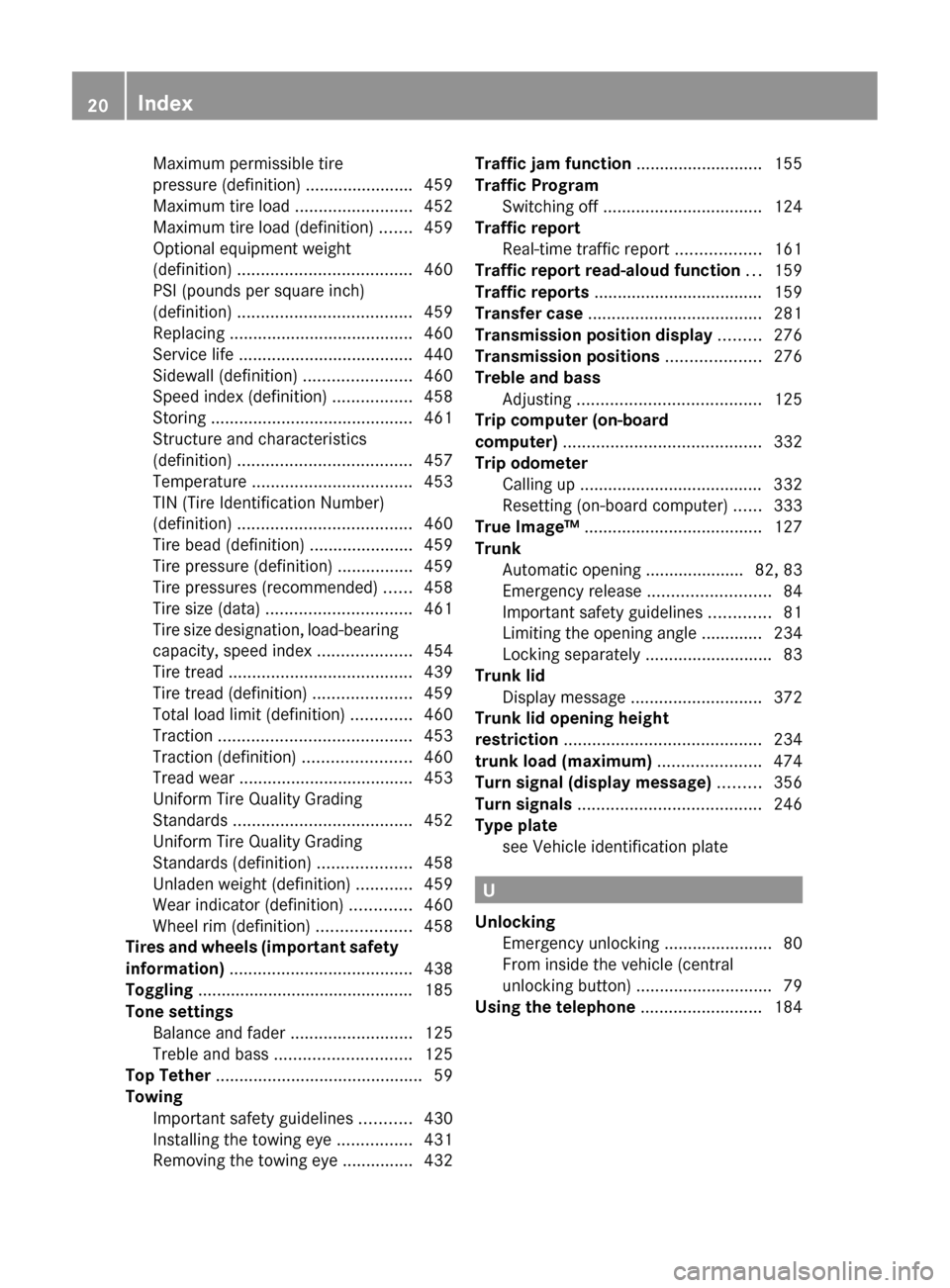
Maximum permissible tire
pressure (definition) ....................... 459
Maximum tire load .........................452
Maximum tire load (definition) .......459
Optional equipment weight
(definition) ..................................... 460
PSI (pounds per square inch)
(definition) ..................................... 459
Replacing ....................................... 460
Service life ..................................... 440
Sidewall (definition) .......................460
Speed index (definition) .................458
Storing ........................................... 461
Structure and characteristics
(definition) ..................................... 457
Temperature .................................. 453
TIN (Tire Identification Number)
(definition) ..................................... 460
Tire bead (definition) ......................459
Tire pressure (definition) ................459
Tire pressures (recommended) ......458
Tire size (data) ............................... 461
Tire size designation, load-bearing
capacity, speed index ....................454
Tire tread ....................................... 439
Tire tread (definition) .....................459
Total load limit (definition) .............460
Traction ......................................... 453
Traction (definition) .......................460
Tread wear ..................................... 453
Uniform Tire Quality Grading
Standards ...................................... 452
Uniform Tire Quality Grading
Standards (definition) ....................458
Unladen weight (definition) ............459
Wear indicator (definition) .............460
Wheel rim (definition) ....................458
Tires and wheels (important safety
information) ....................................... 438
Toggling .............................................. 185
Tone settings Balance and fader ..........................125
Treble and bass ............................. 125
Top Tether ............................................ 59
Towing Important safety guidelines ...........430
Installing the towing eye ................431
Removing the towing eye ...............432Traffic jam function ........................... 155
Traffic Program Switching off .................................. 124
Traffic report
Real-time traffic report ..................161
Traffic report read-aloud function ... 159
Traffic reports .................................... 159
Transfer case ..................................... 281
Transmission position display ......... 276
Transmission positions .................... 276
Treble and bass Adjusting ....................................... 125
Trip computer (on-board
computer) .......................................... 332
Trip odometer Calling up ....................................... 332
Resetting (on-board computer) ......333
True Image™ ...................................... 127
Trunk Automatic opening ..................... 82, 83
Emergency release ..........................84
Important safety guidelines .............81
Limiting the opening angle ............. 234
Locking separately ...........................83
Trunk lid
Display message ............................ 372
Trunk lid opening height
restriction .......................................... 234
trunk load (maximum) ...................... 474
Turn signal (display message) ......... 356
Turn signals ....................................... 246
Type plate see Vehicle identification plate
U
Unlocking Emergency unlocking .......................80
From inside the vehicle (central
unlocking button) ............................. 79
Using the telephone .......................... 184
20Index
Page 46 of 480
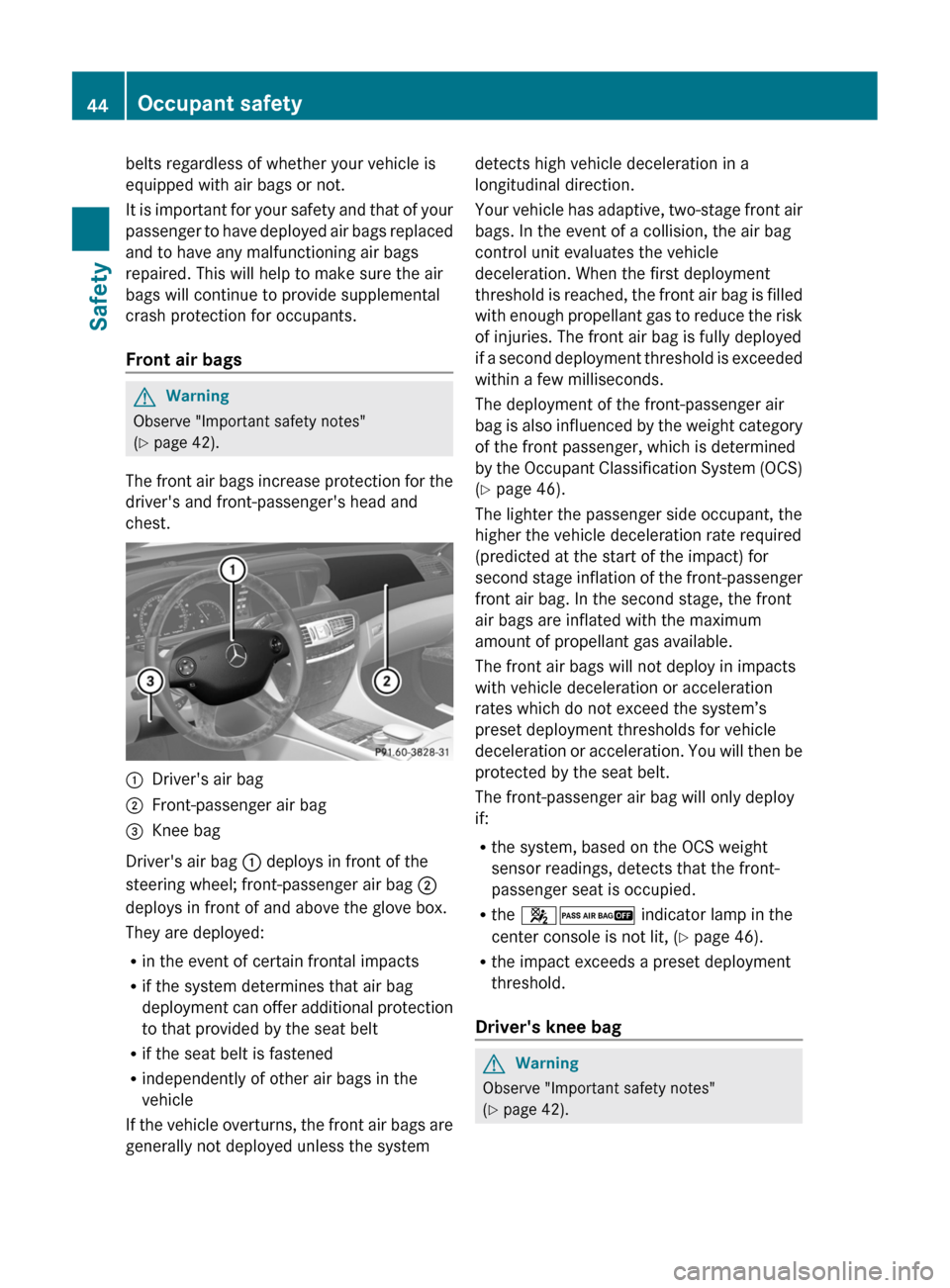
belts regardless of whether your vehicle is
equipped with air bags or not.
It is important for your safety and that of your
passenger to have deployed air bags replaced
and to have any malfunctioning air bags
repaired. This will help to make sure the air
bags will continue to provide supplemental
crash protection for occupants.
Front air bagsGWarning
Observe "Important safety notes"
( Y page 42).
The front air bags increase protection for the
driver's and front-passenger's head and
chest.
:Driver's air bag;Front-passenger air bag=Knee bag
Driver's air bag : deploys in front of the
steering wheel; front-passenger air bag ;
deploys in front of and above the glove box.
They are deployed:
R in the event of certain frontal impacts
R if the system determines that air bag
deployment can offer additional protection
to that provided by the seat belt
R if the seat belt is fastened
R independently of other air bags in the
vehicle
If the vehicle overturns, the front air bags are
generally not deployed unless the system
detects high vehicle deceleration in a
longitudinal direction.
Your vehicle has adaptive, two-stage front air
bags. In the event of a collision, the air bag
control unit evaluates the vehicle
deceleration. When the first deployment
threshold is reached, the front air bag is filled
with enough propellant gas to reduce the risk
of injuries. The front air bag is fully deployed
if a second deployment threshold is exceeded
within a few milliseconds.
The deployment of the front-passenger air
bag is also influenced by the weight category
of the front passenger, which is determined
by the Occupant Classification System (OCS)
( Y page 46).
The lighter the passenger side occupant, the
higher the vehicle deceleration rate required
(predicted at the start of the impact) for
second stage inflation of the front-passenger
front air bag. In the second stage, the front
air bags are inflated with the maximum
amount of propellant gas available.
The front air bags will not deploy in impacts
with vehicle deceleration or acceleration
rates which do not exceed the system’s
preset deployment thresholds for vehicle
deceleration or acceleration. You will then be
protected by the seat belt.
The front-passenger air bag will only deploy
if:
R the system, based on the OCS weight
sensor readings, detects that the front-
passenger seat is occupied.
R the 42 indicator lamp in the
center console is not lit, ( Y page 46).
R the impact exceeds a preset deployment
threshold.
Driver's knee bagGWarning
Observe "Important safety notes"
( Y page 42).
44Occupant safetySafety
Page 47 of 480
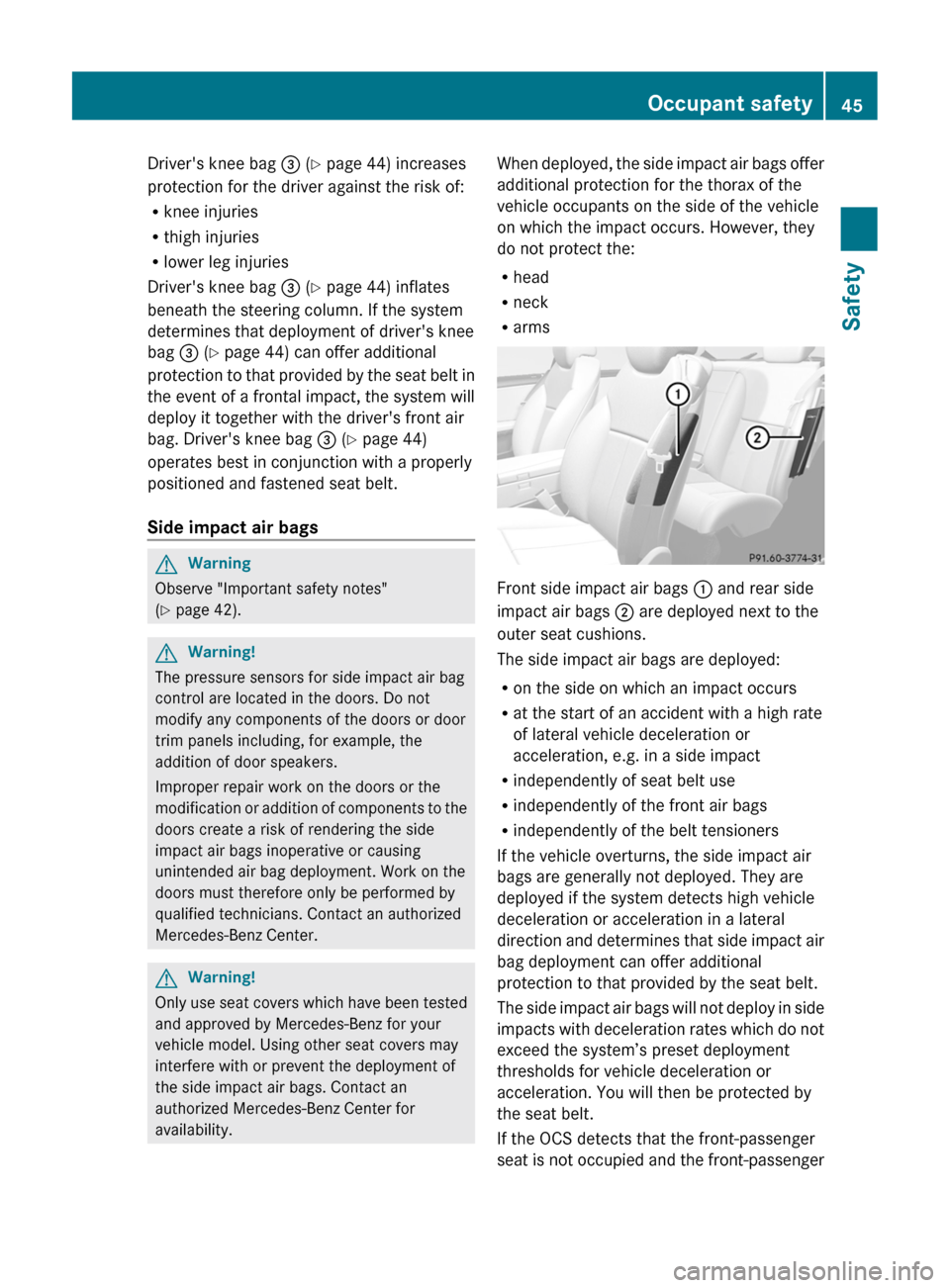
Driver's knee bag = (Y page 44) increases
protection for the driver against the risk of:
Rknee injuries
Rthigh injuries
Rlower leg injuries
Driver's knee bag = (Y page 44) inflates
beneath the steering column. If the system
determines that deployment of driver's knee
bag = (Y page 44) can offer additional
protection to that provided by the seat belt in
the event of a frontal impact, the system will
deploy it together with the driver's front air
bag. Driver's knee bag = (Y page 44)
operates best in conjunction with a properly
positioned and fastened seat belt.
Side impact air bags
GWarning
Observe "Important safety notes"
(Y page 42).
GWarning!
The pressure sensors for side impact air bag
control are located in the doors. Do not
modify any components of the doors or door
trim panels including, for example, the
addition of door speakers.
Improper repair work on the doors or the
modification or addition of components to the
doors create a risk of rendering the side
impact air bags inoperative or causing
unintended air bag deployment. Work on the
doors must therefore only be performed by
qualified technicians. Contact an authorized
Mercedes-Benz Center.
GWarning!
Only use seat covers which have been tested
and approved by Mercedes-Benz for your
vehicle model. Using other seat covers may
interfere with or prevent the deployment of
the side impact air bags. Contact an
authorized Mercedes-Benz Center for
availability.
When deployed, the side impact air bags offer
additional protection for the thorax of the
vehicle occupants on the side of the vehicle
on which the impact occurs. However, they
do not protect the:
Rhead
Rneck
Rarms
Front side impact air bags : and rear side
impact air bags ; are deployed next to the
outer seat cushions.
The side impact air bags are deployed:
Ron the side on which an impact occurs
Rat the start of an accident with a high rate
of lateral vehicle deceleration or
acceleration, e.g. in a side impact
Rindependently of seat belt use
Rindependently of the front air bags
Rindependently of the belt tensioners
If the vehicle overturns, the side impact air
bags are generally not deployed. They are
deployed if the system detects high vehicle
deceleration or acceleration in a lateral
direction and determines that side impact air
bag deployment can offer additional
protection to that provided by the seat belt.
The side impact air bags will not deploy in side
impacts with deceleration rates which do not
exceed the system’s preset deployment
thresholds for vehicle deceleration or
acceleration. You will then be protected by
the seat belt.
If the OCS detects that the front-passenger
seat is not occupied and the front-passenger
Occupant safety45SafetyZ
Page 48 of 480

seat belt is not fastened (the belt tongue is
not engaged in the seat belt buckle), the side
impact air bag on the front-passenger side
will not deploy. The side impact air bag on the
front-passenger side will deploy if the front-
passenger seat belt is fastened, regardless of
whether the front-passenger seat is occupied
or not.
Window curtain air bags
GWarning
Observe "Important safety notes"
(Y page 42).
The window curtain air bags enhance the level
of protection for the head (but not chest or
arms) of the vehicle occupants on the side of
the vehicle on which the impact occurs.
The window curtain air bags are integrated
into the side of the roof frame and deploy in
the area extending from the front door (A-
pillar) to the rear sidewall (C-pillar).
Window curtain air bags : are deployed:
Ron the side on which an impact occurs
Rat the start of an accident with a high rate
of lateral vehicle deceleration or
acceleration, e.g. in a side impact
Rregardless of whether the front-passenger
seat is occupied
Rindependently of seat belt use
Rif the vehicle overturns and the system
determines that window curtain air bag
deployment can offer additional protection
to that provided by the seat belt
Rindependently of the front air bags
Window curtain air bags : will not deploy in
impacts with deceleration rates which do not
exceed the system’s preset deployment
thresholds for vehicle deceleration or
acceleration. You will then be protected by
the seat belt.
Occupant classification system (OCS)
Operating principles of the Occupant
Classification System
OCS categorizes the occupant on the front-
passenger seat by means of a weight sensor.
The front-passenger front air bag is
automatically deactivated for certain weight
categories. The respective status can be
recognized by the 42 indicator
lamp. With the 42 indicator
lamp illuminated, the front-passenger front
air bag is deactivated.
The system does not deactivate:
Rthe side impact air bag
Rthe window curtain air bag
Rthe Emergency Tensioning Devices
To be classified correctly, the front passenger
must sit:
Rwith the seat belt properly fastened
Rin a position that is as upright as possible
with the back against the seat backrest
Rwith their feet on the floor
If the front-passenger's weight is transferred
to another object in the vehicle (e.g. by
leaning on armrests), OCS may not be able to
approximate the occupant's weight category.
If the front passenger seat, the seat cover, or
the seat cushion are damaged, have the
necessary repair work carried out at an
authorized Mercedes-Benz Center.
For reasons of safety, Mercedes-Benz
recommends that you only use seat
46Occupant safetySafety
Page 49 of 480
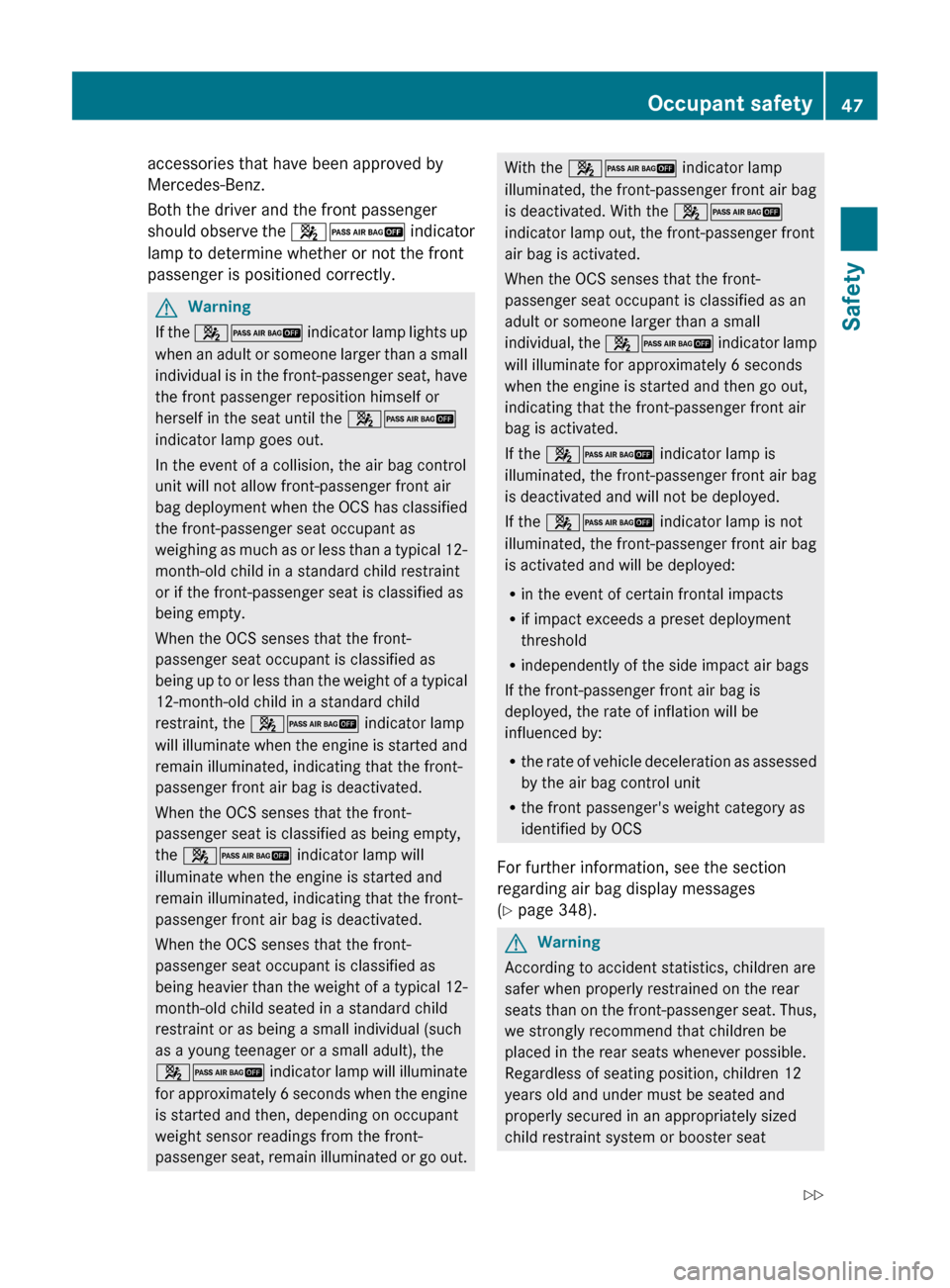
accessories that have been approved by
Mercedes-Benz.
Both the driver and the front passenger
should observe the 42 indicator
lamp to determine whether or not the front
passenger is positioned correctly.GWarning
If the 42 indicator lamp lights up
when an adult or someone larger than a small
individual is in the front-passenger seat, have
the front passenger reposition himself or
herself in the seat until the 42
indicator lamp goes out.
In the event of a collision, the air bag control
unit will not allow front-passenger front air
bag deployment when the OCS has classified
the front-passenger seat occupant as
weighing as much as or less than a typical 12-
month-old child in a standard child restraint
or if the front-passenger seat is classified as
being empty.
When the OCS senses that the front-
passenger seat occupant is classified as
being up to or less than the weight of a typical
12-month-old child in a standard child
restraint, the 42 indicator lamp
will illuminate when the engine is started and
remain illuminated, indicating that the front-
passenger front air bag is deactivated.
When the OCS senses that the front-
passenger seat is classified as being empty,
the 42 indicator lamp will
illuminate when the engine is started and
remain illuminated, indicating that the front-
passenger front air bag is deactivated.
When the OCS senses that the front-
passenger seat occupant is classified as
being heavier than the weight of a typical 12-
month-old child seated in a standard child
restraint or as being a small individual (such
as a young teenager or a small adult), the
42 indicator lamp will illuminate
for approximately 6 seconds when the engine
is started and then, depending on occupant
weight sensor readings from the front-
passenger seat, remain illuminated or go out.
With the 42 indicator lamp
illuminated, the front-passenger front air bag
is deactivated. With the 42
indicator lamp out, the front-passenger front
air bag is activated.
When the OCS senses that the front-
passenger seat occupant is classified as an
adult or someone larger than a small
individual, the 42 indicator lamp
will illuminate for approximately 6 seconds
when the engine is started and then go out,
indicating that the front-passenger front air
bag is activated.
If the 42 indicator lamp is
illuminated, the front-passenger front air bag
is deactivated and will not be deployed.
If the 42 indicator lamp is not
illuminated, the front-passenger front air bag
is activated and will be deployed:
R in the event of certain frontal impacts
R if impact exceeds a preset deployment
threshold
R independently of the side impact air bags
If the front-passenger front air bag is
deployed, the rate of inflation will be
influenced by:
R the rate of vehicle deceleration as assessed
by the air bag control unit
R the front passenger's weight category as
identified by OCS
For further information, see the section
regarding air bag display messages
( Y page 348).GWarning
According to accident statistics, children are
safer when properly restrained on the rear
seats than on the front-passenger seat. Thus,
we strongly recommend that children be
placed in the rear seats whenever possible.
Regardless of seating position, children 12
years old and under must be seated and
properly secured in an appropriately sized
child restraint system or booster seat
Occupant safety47SafetyZ
Page 53 of 480
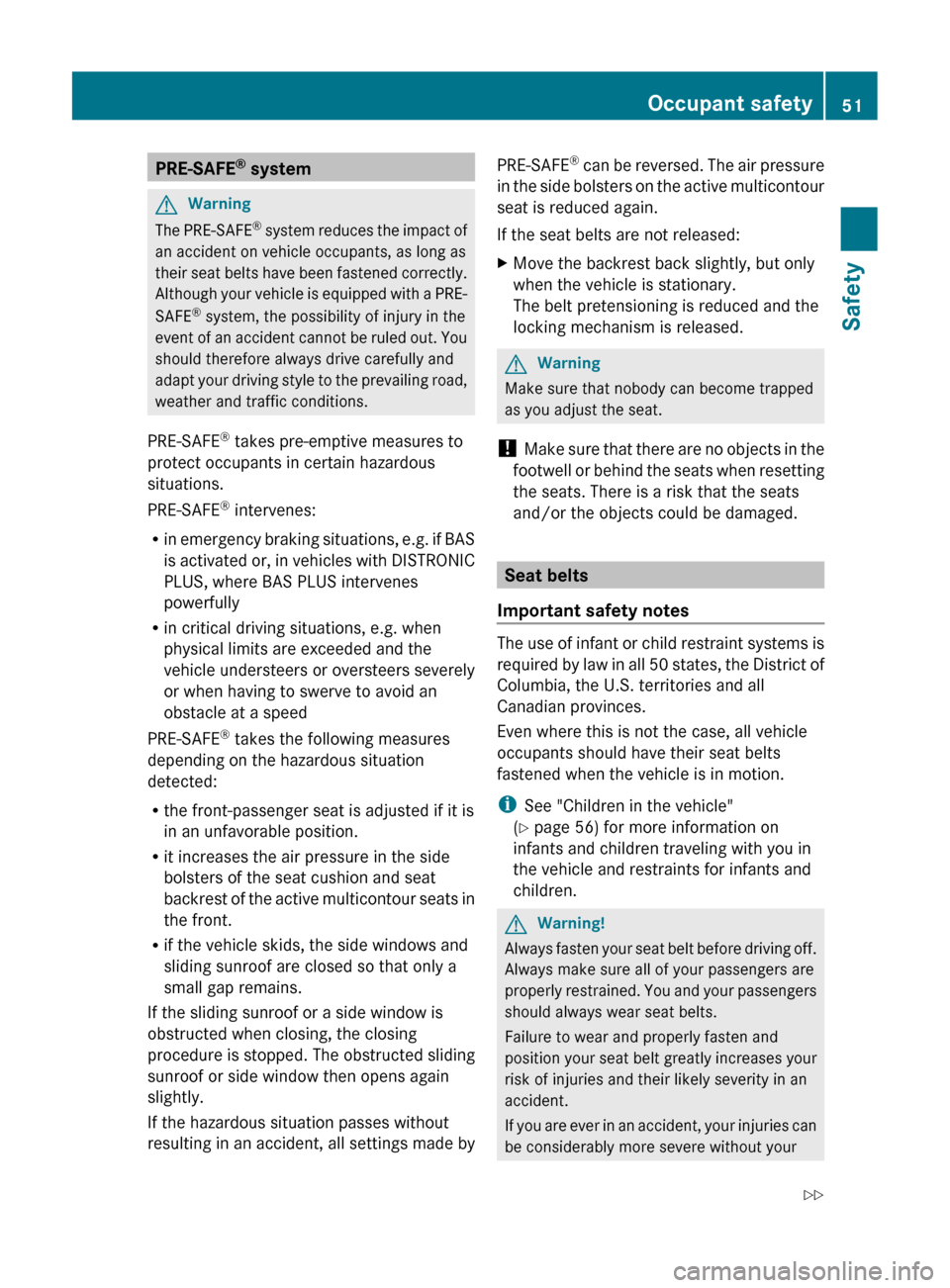
PRE-SAFE®
systemGWarning
The PRE-SAFE ®
system reduces the impact of
an accident on vehicle occupants, as long as
their seat belts have been fastened correctly.
Although your vehicle is equipped with a PRE-
SAFE ®
system, the possibility of injury in the
event of an accident cannot be ruled out. You
should therefore always drive carefully and
adapt your driving style to the prevailing road,
weather and traffic conditions.
PRE-SAFE ®
takes pre-emptive measures to
protect occupants in certain hazardous
situations.
PRE-SAFE ®
intervenes:
R in emergency braking situations, e.g. if BAS
is activated or, in vehicles with DISTRONIC
PLUS, where BAS PLUS intervenes
powerfully
R in critical driving situations, e.g. when
physical limits are exceeded and the
vehicle understeers or oversteers severely
or when having to swerve to avoid an
obstacle at a speed
PRE-SAFE ®
takes the following measures
depending on the hazardous situation
detected:
R the front-passenger seat is adjusted if it is
in an unfavorable position.
R it increases the air pressure in the side
bolsters of the seat cushion and seat
backrest of the active multicontour seats in
the front.
R if the vehicle skids, the side windows and
sliding sunroof are closed so that only a
small gap remains.
If the sliding sunroof or a side window is
obstructed when closing, the closing
procedure is stopped. The obstructed sliding
sunroof or side window then opens again
slightly.
If the hazardous situation passes without
resulting in an accident, all settings made by
PRE-SAFE ®
can be reversed. The air pressure
in the side bolsters on the active multicontour
seat is reduced again.
If the seat belts are not released:XMove the backrest back slightly, but only
when the vehicle is stationary.
The belt pretensioning is reduced and the
locking mechanism is released.GWarning
Make sure that nobody can become trapped
as you adjust the seat.
! Make sure that there are no objects in the
footwell or behind the seats when resetting
the seats. There is a risk that the seats
and/or the objects could be damaged.
Seat belts
Important safety notes
The use of infant or child restraint systems is
required by law in all 50 states, the District of
Columbia, the U.S. territories and all
Canadian provinces.
Even where this is not the case, all vehicle
occupants should have their seat belts
fastened when the vehicle is in motion.
i See "Children in the vehicle"
( Y page 56) for more information on
infants and children traveling with you in
the vehicle and restraints for infants and
children.
GWarning!
Always fasten your seat belt before driving off.
Always make sure all of your passengers are
properly restrained. You and your passengers
should always wear seat belts.
Failure to wear and properly fasten and
position your seat belt greatly increases your
risk of injuries and their likely severity in an
accident.
If you are ever in an accident, your injuries can
be considerably more severe without your
Occupant safety51SafetyZ
Page 54 of 480
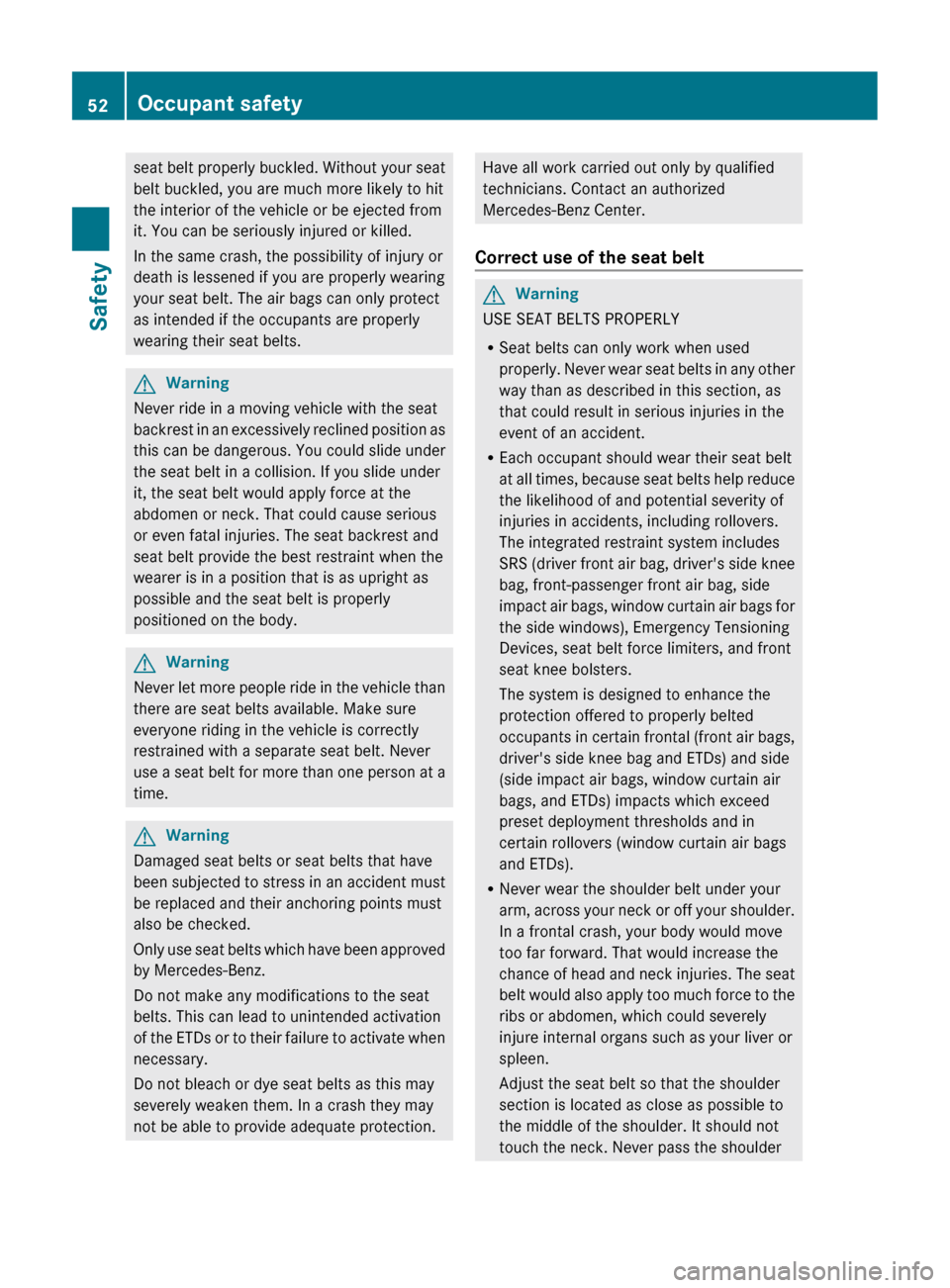
seat belt properly buckled. Without your seat
belt buckled, you are much more likely to hit
the interior of the vehicle or be ejected from
it. You can be seriously injured or killed.
In the same crash, the possibility of injury or
death is lessened if you are properly wearing
your seat belt. The air bags can only protect
as intended if the occupants are properly
wearing their seat belts.GWarning
Never ride in a moving vehicle with the seat
backrest in an excessively reclined position as
this can be dangerous. You could slide under
the seat belt in a collision. If you slide under
it, the seat belt would apply force at the
abdomen or neck. That could cause serious
or even fatal injuries. The seat backrest and
seat belt provide the best restraint when the
wearer is in a position that is as upright as
possible and the seat belt is properly
positioned on the body.
GWarning
Never let more people ride in the vehicle than
there are seat belts available. Make sure
everyone riding in the vehicle is correctly
restrained with a separate seat belt. Never
use a seat belt for more than one person at a
time.
GWarning
Damaged seat belts or seat belts that have
been subjected to stress in an accident must
be replaced and their anchoring points must
also be checked.
Only use seat belts which have been approved
by Mercedes-Benz.
Do not make any modifications to the seat
belts. This can lead to unintended activation
of the ETDs or to their failure to activate when
necessary.
Do not bleach or dye seat belts as this may
severely weaken them. In a crash they may
not be able to provide adequate protection.
Have all work carried out only by qualified
technicians. Contact an authorized
Mercedes-Benz Center.
Correct use of the seat beltGWarning
USE SEAT BELTS PROPERLY
R Seat belts can only work when used
properly. Never wear seat belts in any other
way than as described in this section, as
that could result in serious injuries in the
event of an accident.
R Each occupant should wear their seat belt
at all times, because seat belts help reduce
the likelihood of and potential severity of
injuries in accidents, including rollovers.
The integrated restraint system includes
SRS (driver front air bag, driver's side knee
bag, front-passenger front air bag, side
impact air bags, window curtain air bags for
the side windows), Emergency Tensioning
Devices, seat belt force limiters, and front
seat knee bolsters.
The system is designed to enhance the
protection offered to properly belted
occupants in certain frontal (front air bags,
driver's side knee bag and ETDs) and side
(side impact air bags, window curtain air
bags, and ETDs) impacts which exceed
preset deployment thresholds and in
certain rollovers (window curtain air bags
and ETDs).
R Never wear the shoulder belt under your
arm, across your neck or off your shoulder.
In a frontal crash, your body would move
too far forward. That would increase the
chance of head and neck injuries. The seat
belt would also apply too much force to the
ribs or abdomen, which could severely
injure internal organs such as your liver or
spleen.
Adjust the seat belt so that the shoulder
section is located as close as possible to
the middle of the shoulder. It should not
touch the neck. Never pass the shoulder
52Occupant safetySafety